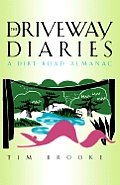 The Driveway Diaries: A Dirt Road Almanac, by Tim Brooke is a good spring read. If you like Michael Pollan's work (especially my favorite, his book on gardening - Second Nature) or Bill Bryson's books, there's a good chance you'll like this little volume of essays on how a professor from England buys a house out in the country in Vermont.
The Driveway Diaries: A Dirt Road Almanac, by Tim Brooke is a good spring read. If you like Michael Pollan's work (especially my favorite, his book on gardening - Second Nature) or Bill Bryson's books, there's a good chance you'll like this little volume of essays on how a professor from England buys a house out in the country in Vermont.The book itself is interestingly shaped - more nearly square than most paperbacks (and not like the illustration here). It's the width of a trade paperback, but only as tall as a mass market paperback. This gives it a slight "picture book" or artsy feel - though there aren't any pictures, except for the graphic woodcut-like design on the cover.
Not every essay thrilled me, but most had me nodding my head, saying uh huh, that's so right, and comparing the differences in roads and driveways between Illinois (where I grew up) and Michigan and Vermont. I spent a bit of time thinking about the physical & environmental differences between rural, suburban, urban, and small town areas I've lived in, and thinking of "My Life in Driveways" (which would make an interesting blog meme: describe each driveway or lack thereof in your life), which was one of the essays that I most enjoyed.
His descriptions of different kinds of ice, shovelling, and problems with winter driveways made me appreciate the crocuses, daffodils and robins now (finally) here. And Brooke has a wonderfully anthropomorphic essay on the differences between tulips, daffodils, and irises that was one of the best parts of the book.
Now that I come to think of it, a driveway is the opposite of a porch. The porch was designed as a halfway habitation: on the porch, the homeowner was sheltered and at home, but was also visible and available to passers-by, able to wave, call out, chat. The drieway assumes that you don't want to talk to passers-by, and that there aren't any anyway, as they're all in their cars. It means that instead of the intervening distance between private and public being small and joined by words, it is large, and one passes through it enclosed in a car. -- Tim Brooke, in The Driveway Diaries: A Dirt Road Almanac, p. 79.
No comments:
Post a Comment